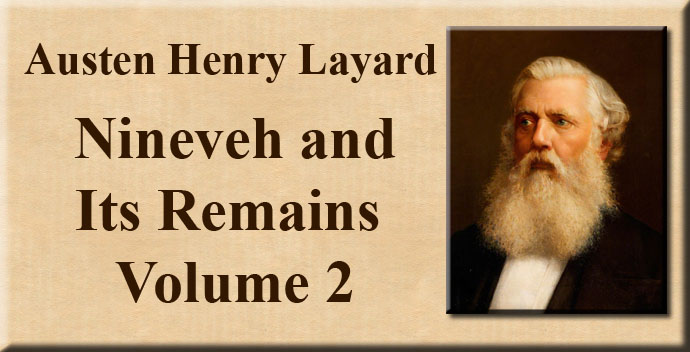
Nineveh and Its Remains
Volume 2
By Austen Henry Layard, ESQ. D.C.L.
Part 2 - Chapter 3
THE remarks in the foregoing chapter, on the architecture of the Assyrians, naturally lead to the consideration of the state of the arts in general amongst them. It is impossible to examine the monuments of Assyria without being convinced, that the people who raised them had acquired a skill in sculpture and painting, and a knowledge of design and even composition, indicating an advanced state of civilisation. It is very remarkable, that the most ancient ruins show this knowledge in the greatest perfection, attained by the Assyrians. The bas-relief representing the lion-hunt, now in the British Museum, is a good illustration of the earliest school of Assyrian art yet known. It far exceeds the sculptures of Khorsabad, Kouyunjik, or the later palaces of Nimroud, in the vigour of the treatment, the elegance of the forms, and in what the French aptly term "mouvement." At the same time it is eminently distinguished from them by the evident attempt at composition, — by the artistical arrangement of the groups. The sculptors who worked at Khorsabad, and Kouyunjik, had perhaps acquired more skill in handling their tools. Their work is frequently superior to that of the earlier artist, in delicacy of execution — in the details of the features, for instance — and in the boldness of the relief; but the slightest acquaintance with Assyrian monuments will show, that they were greatly inferior to their ancestors in the higher branches of art — in the treatment of a subject, and in beauty and variety of form. This decline of art, after suddenly attaining its greatest perfection in its earliest stage, is a fact presented by almost every people, ancient and modern, with which we are acquainted. In Egypt, the most ancient monuments display the purest forms, and the most elegant decorations. A rapid retrogression, after a certain period, is most apparent, and serves to indicate approximatively the epoch of most of her remains. In the history of Greek, and Roman art, this sudden rise and rapid fall are equally apparent. Even changes in royal dynasties have had an influence upon art; as a glance at monuments of that part of the East of which we are specially treating will show. Thus the sculpture of Persia, as that of Assyria, was in its best state at the time of the earliest monarchs, and gradually declined until the fall of the empire. After the Greek invasion, it revived under the first kings of the Arsacid branch; Greek taste still exercising an influence over the Iranian provinces. How rapidly art degenerated to the most barbarous forms, the medals and monuments of the later Arsacids abundantly prove. When the Sassanians restored the old Persian monarchy, and endeavoured to restore the ancient religion and sacred ceremonies of the empire, art again appears to have received a momentary impulse. The coins, gems, and rock sculptures of the first kings of this dynasty, are distinguished by considerable elegance, and spirit of design, and beauty of form. But the decay was as rapid under them, as it had been under their predecessors. Even before the Khosraws raised the glory and power of the empire to its highest pitch, art was fast degenerating. By the time of Yezdigird, it had become even more rude, and barbarous, than in the last days of the Arsacids. This decline in art, may be accounted for by supposing that, in the infancy of a people, or after the occurrence of any great event, having a very decided influence upon their manners, their religion, or their political state, nature was the chief, if not the only, object of study. When a certain proficiency had been attained, and no violent changes took place to shake the established order of things, the artist, instead of endeavouring to imitate that which he saw in nature, received as correct delineations the works of his predecessors, and made them his types and his models. In some countries, as in Egypt, religion may have contributed to this result. Whilst the imagination, as well as the hand, was fettered by prejudices, and even by laws, or whilst indolence or ignorance led to the mere servile copying of what had been done before, it may easily be conceived how rapidly a deviation from correctness of form would take place. As each copied the errors of those who preceded him, and added to them himself, it is not wonderful if, ere long, the whole became one great error. It is to be feared, that this prescriptive love of imitation has exercised no less influence on modern art, than it did upon the arts of the ancients. As the earliest specimens of Assyrian art which we possess are the best, it is natural to conclude that either there are other monuments still undiscovered, which would tend to show a gradual progression, or that such monuments did once exist, but have long since perished; otherwise it must be inferred, that those who raised the Assyrian edifice, derived their knowledge directly from another people, or merely imitated what they had seen in a foreign land. Some are inclined to look upon the style, and character of these early sculptures, as purely Egyptian. But there is such a disparity in the mode of treatment, and in the execution, that the Egyptian origin of Assyrian art appears to me, to be a question open to considerable doubt. That which they have in common would mark the first efforts of any people, of a certain intellectual order, to imitate nature. The want of relative proportions in the figures, and the ignorance of perspective — the full eye in the side face, and the warriors fighting, and the bodies of the dead scattered above, or below the principal figures, — are as characteristic of all early productions of art, as they are of the rude attempts at delineation of children. It is only in the later monuments of Nineveh, that we find evident and direct traces of Egyptian influence; as in the sitting sphinxes and ivories of Nimroud, and in the lotus-shaped ornaments of Khorsabad and Kouyunjik; perhaps also in the custom which then prevailed of inserting the name of the king, or of the castle upon, or immediately above, their sculptured representations. Neither the ornaments of the earliest palace of Nimroud, nor the costumes, nor the elaborate nature of the embroideries upon the robes, with the groups of human figures and animals, nor the mythological symbols, are of an Egyptian character; they show a very different taste and style. The principal distinction between Assyrian, and Egyptian art appears to be, that in the one, conventional forms were much more strictly adhered to than in the other. The angular mode of treatment so conspicuous in Egyptian monuments, even in the delineation of every object, is not perceivable in those of Assyria. Had the arts of the two countries been derived from the same source — or had one been imitated from the other — they would surely have displayed the same striking peculiarity. The Assyrians, less fettered, sought to imitate nature more closely, however rude and unsuccessful their attempts may have been; and this is proved by the constant endeavour to show the muscles, veins, and anatomical proportions of the human figure. We must not lose sight of the assertion of Moses of Chorene, — derived no doubt from ancient traditions, if not from direct historical evidence, — that when Ninus founded the Assyrian empire, a people far advanced in civilisation, and in the knowledge of the arts and sciences, whose works the conquerors endeavoured to destroy, were already in possession of the country.1 Who that people may have been, we cannot now even conjecture. The same mystery hangs over the origin of the arts in Egypt, and in Assyria. They may have been derived, before the introduction of any conventional forms, from a common source — from a people whose very name, and the proofs of whose former existence, may have perished even before tradition begins. The monuments of Assyria furnish us with very important data, as to the origin of many branches of art, subsequently brought to the highest perfection in Asia Minor, and Greece. I conceive the Assyrian influence on Asia Minor to have been twofold. In the first place, direct, during the time of the greatest prosperity of the Assyrian monarchy or empire, when, as it has been shown, the power of its kings extended over that country; in the second, indirect, through Persia, after the destruction of Nineveh. Of the influence exercised upon the arts of western Asia, during the early occupation of the Assyrians, few traces have hitherto been discovered, unless the remarkable monuments on the site of ancient Pteria or Pterium belong to this period.2 The evident connection between the divinities, and sacred emblems worshipped in various parts of Asia Minor, and those of Assyria, will be hereafter particularly pointed out. The Assyrian origin of these monuments, and of these religious symbols, once admitted, we shall have no difficulty in recognising the influence of Assyria on the arts and customs of Asia Minor. The antiquities of that country prior to a well-known period, the Persian occupation, have been but little investigated. Few remains of an earlier epoch have yet been discovered. That such remains do exist, perhaps buried under ground, I have little doubt. It is most probable that when we have additional materials for inquiry, we shall be still more convinced of this Assyrian influence, pointed out by Herodotus, when he declares the founder of the kingdom of Lydia to have been a descendant of Ninus, and by other authors who mention the Syrian, or Assyrian descent of many nations of Asia Minor.3 But the second, or indirect, period of this influence, is very fully and completely illustrated by the monuments of Asia Minor, of the time of the Persian domination. The known connection between these monuments, and the archaic forms of Greek art, renders this part of the inquiry both important and interesting. The Xanthian marbles, acquired for this country by Sir Charles Fellows, and now in the British Museum, are remarkable illustrations of the threefold connection between Assyria and Persia, Persia and Asia Minor, and Asia Minor and Greece. Were those marbles properly arranged, and placed in chronological order, they would afford a most useful lesson; arid would enable even a superficial observer to trace the gradual progress of art, from its primitive rudeness to the most classic conceptions of the Greek sculptor. Not that he would find either style, the pure Assyrian or the Greek, in its greatest perfection; but he would be able to see how a closer imitation of nature, a gradual refinement of taste, and additional study, had converted the hard and rigid lines of the Assyrians, into the flowing draperies, and classic forms of the highest order of art.4 I have termed this second period that of indirect influence, because the arts did not then penetrate directly into Asia Minor from Assyria; but were conveyed thither through the Persians. The Assyrian empire had already existed for centuries, and had exercised the supreme power over Asia, before it was disputed by the kingdoms of Persia and Media, united under one monarch. The Persians were probably a rude people, possessing neither a literature nor arts of their own, but deriving what they had from their civilised neighbours.5 We have no earlier specimen of Persian writing than the inscription containing the name of Cyrus, on the ruins supposed to be those of his tomb, at Murghaub; nor any earlier remains of Persian art than the buildings and sculptures of Persepolis, and other monuments to be attributed beyond a question to the kings of the Achsemenian dynasty. It has already been shown that the writing of the Persians was imitated from the Assyrians, and it can as easily be proved that their sculptures were derived from the same source. The monuments of Persepolis establish this beyond a doubt.6 They exhibit precisely the same mode of treatment, the same forms, the same peculiarities in the arrangement of the bas-reliefs against the walls, the same entrances formed by gigantic winged animals with human heads, and, finally, the same religious emblems. Had this identity been displayed in one instance alone, we might have attributed it to chance, or to mere casual intercourse; but when it pervades the whole system, we can scarcely doubt that one was a close copy, an imitation, of the other. That the peculiar characteristics of the Persepolitan sculptures were derived from the monuments of the second Assyrian dynasty — that is, from those of the latest Assyrian period — can be proved by the similarity of shape in the ornaments, and in the costume of many of the figures. Thus, the head-dress of the winged monsters forming the portals is lofty, squared, and richly ornamented at the top, resembling those of Khorsabad and Kouyunjik, and differing from the round, unornamented cap of the older figures at Nimroud.7
The processions of warriors, captives, and tribute-bearers at Persepolis, are in every respect similar to those on the walls of Nimroud and Khorsabad; we have the same mode of treatment in the figures, the same way of portraying the eyes and hair. The Persian artist introduced folds into the draperies; but, with this exception, he certainly did not improve upon his Assyrian model. On the contrary, his work is greatly inferior to it in the general arrangement of the groups, and in the elegance of the details. From whence the Persians obtained the column, and other architectural ornaments used at Persepolis, it may be more difficult to determine. We have seen that the column was not unknown to the later Assyrians, although it does not appear to have been employed in the construction of their palaces. The Persians, therefore, may have partly derived their knowledge from them, and partly, perhaps principally, from the Egyptians; whom, before the foundation of Persepolis, they had already conquered. It will be observed that the capitals of their columns frequently assume the shape of Assyrian religious types, the bull for instance; whilst other portions of them nearly resemble in the form of their ornaments, though not in their proportions, those of Egypt.
There is one monument, however, from Xanthus, which particularly deserves notice, from its connection with Persian and Assyrian art and religious emblems. I allude to the fragment of a tomb in the British Museum, on which is represented a figure struggling with, and piercing, a rampant lion. The sculpture is so peculiarly Assyrian in its treatment, identical representations being found on the monuments and cylinders of Assyria, that there can be no doubt as to its origin. The combat with the lion was either a pure religious type, or a symbol of the power and wisdom of the king, which, first devised by the Assyrians, was afterwards used by the Persians, and is everywhere to be found on their monuments. I add another illustration — a bas-relief from the Harpy Tomb, conjectured to represent the three Graces between Juno and Venus. The forms of the chairs and the general treatment is Assyrian. The calf sucking the cow, originally an Assyrian emblem, occurs on an altar in a bas-relief discovered at Khorsabad, and is found among the ivories from Nimroud.8
It has already been mentioned that many architectural ornaments, known to the Assyrians, passed from them, directly or indirectly, into Greece. The Ionic column has been cited as an instance. We have, moreover, in the earliest monuments of Nineveh, that graceful ornament, commonly called the honeysuckle, which was so extensively used in Greece, and is to this day more generally employed than any other moulding. In Assyria, as I have pointed out, it was invested with sacred properties, and was either a symbol or an object of worship. That the similarity between the Assyrian and Greek ornament is not accidental, seems to be proved, beyond a question, by the alternation of the lotus or tulip, whichever this flower may be, with the honeysuckle; by the number of leaves or petals of the flower, and by their proceeding in both from a semicircle, supported by two tendrils or scrolls.10 The same ornament occurs, even in India, on a lath erected by Asoka at Allahabad (about B. c. 250); but whether introduced by the Greeks — which, from the date of the erection of the monument, shortly after the Macedonian invasion, is not improbable — or whether derived directly from another source, I cannot venture to decide.11
That the Assyrians possessed a highly refined taste can hardly be questioned, when we find them inventing an ornament which the Greeks afterwards, with few additions and improvements, so generally adopted in their most classic monuments. Others, no less beautiful, continually occur in the most ancient bas-reliefs of Nimroud. The sacred bull, with expanded wings, and the wild goat, are introduced kneeling
The guilloche, or intertwining bands, continually found on Greek monuments, and still in common use, was also well known to the Assyrians, and was one of their most favourite ornaments. It was embroidered on their robes, embossed on their arms and chariots, and painted on their walls.13 This purity, and elegance of taste, was equally displayed in the garments, arms, furniture, and trappings of the Assyrians. The robes of the king were most elaborately embroidered. The part covering his breast was generally adorned, not only with flowers and scroll-work, but with groups of figures, animals, and even hunting and battle scenes.14 In other parts of his dress similar designs were introduced; and rows of tassels or fringes were carried round the borders. The ear-rings, necklaces, armlets, and bracelets were all of the most elegant forms. The clasps, and ends of the bracelets were frequently in the shape of the heads of rams and bulls, resembling our modern jewellery. The ear-rings have generally on the later monuments, particularly in the bas-reliefs of Khorsabad, the form of a cross.
Ornaments, in the form of the heads of animals, chiefly the lion, bull, and ram, were very generally introduced even in parts of the chariot, the harness of the horses, and domestic furniture. In this respect the Assyrians resembled the Egyptians. Their tables, thrones, and couches were made both of metal and wood, and probably inlaid with ivory. We learn from Herodotus, that those in the temple of Belus at Babylon, were of solid gold.15 The chair represented on the earliest monuments is without a back, the legs are tastefully carved, and the seat is adorned with the heads of rams. The cushion appears to have been made of some rich stuff, embroidered or painted. The legs were strengthened by a cross-bar, and frequently ended in the feet of a lion, or the hoofs of a bull, either of gold, silver, or bronze.16 On the monuments of Khorsabad, and
in the rock-tablets of Malthaiyah, we find representations of chairs supported by animals, and by human figures, sometimes prisoners, like the Caryatids of the Greeks. In this they resembled the arm-chairs of Egypt, but appear to have been more massive. This mode of ornamenting the throne of the king was adopted by the Persians, and is continually seen in the sculptures of Persepolis. The lion was both an ornament and support, in the throne of Solomon. " And there were stays (or arms) on either side on the place of the seat, and two lions stood beside the stays (or arms). And twelve lions stood there, on the one side and on the other upon the six steps."17 This description corresponds with the Assyrian chairs, the arms of which are frequently supported by the figures of animals.18
The tables and chairs were frequently shaped like our camp stools, and may have been made to close: they were also generally terminated by the feet of animals.
The square basket, or utensil, so frequently represented in the Assyrian sculptures, as carried by the winged figures, is generally very elaborately decorated. In the early bas-reliefs of Nimroud, a group of figures is often introduced upon it, and the margin is richly adorned with the honeysuckle ornament, or with the intertwining bands. The corners to which the handle is attached, are frequently in the form of eagles. In the sculptures of Khorsabad, this square utensil is made to represent a basket or wicker-work; but in the early sculptures it appears to be of metal. The arms, domestic furniture, utensils, personal ornaments, and details I have described, show a very refined and cultivated taste. In this respect, the most ancient Assyrian monuments with which we are acquainted, greatly exceed the later. Many forms had been preserved, as in the swords, bracelets, and armlets; but they had evidently degenerated, and are more coarsely designed in the sculptures. This is also evident in the embroideries of the robes, and in the details of the chariots. We see the same love of elaborate and profuse decoration, but not that elegance and variety, so conspicuous in the ornaments of the first period. The kneeling bull or wild goat, the graceful flower, and the groups of men and animals skilfully combined, are succeeded by a profusion of rosettes, circles, and squares, covering the whole surface of the dress, or the sides of the chariots. Although there is a certain richness of appearance, yet the classic forms, if the term may be used, of the earlier artists, are wanting.
The bas-reliefs and sculptures of the Assyrians, except, probably, those in black marble and basalt, were either partly or entirely painted. I could not ascertain whether the ground, as well as the figures, had been coloured; but M. Flandin states24 that he could trace on the bas-reliefs of Khorsabad a tint of yellow ochre on all parts not otherwise painted. It is not improbable that such was the case, particularly in the Khorsabad and Kouyunjik palaces, as a similar practice existed in Egypt. There were fewer remains of colour at Nimroud, than in the ruins explored by M. Botta. I could distinguish them on the hair, beard, and eyes, on the sandals and bows, on the tongues of the eagle-headed figures, and very faintly on a garland round the head of a winged priest, and on the representation of fire in the bas-relief of a siege. These traces being only found on certain parts of the human face, and on particular objects, almost lead to the conjecture that the earliest Assyrian sculptures were but partially coloured. At Khorsabad the remains of paint were far more general, being found on the draperies, the mitre of the king, the flowers carried by the winged figures, the harness of the horses, the chariots, and the trees. In the bas-reliefs representing a siege, the flames issuing from the houses, and the torches carried by the assailants, were invariably coloured red. The passage in Ezekiel, describing the interior of the Assyrian palaces, so completely corresponds with, and illustrates, the monuments of Nimroud and Khorsabad, that it deserves particular notice in this place. The prophet, in typifying the corruptions which had crept into the religious system of the Jews, and the idolatrous practices borrowed from nations with whom they had been brought into contact, thus illustrates the influence of the Assyrians. " She saw men pourtrayed upon the wall, the images of the Chaldeans pourtrayed with vermilion, girded with girdles upon their loins, exceeding in dyed attire upon their heads, all of them princes to look to, after the manner of the Babylonians of Chaldea, the land of their nativity."25 Ezekiel, it will be remembered, prophesied on the banks of the Chebar, a river which, whether it can be identified with the Khabour of the Arabs (the Chaboras of the Greeks), flowing through the plains of Mesopotamia, and falling into the Euphrates near Karkeraish (Circesium), or with another of the same name rising in the mountains of Kurdistan, and joining the Tigris above Mosul, was certainly in the immediate vicinity of Nineveh. In the passage quoted, the prophet is referring to a period previous to the final destruction of the Assyrian capital, an event which he most probably witnessed, as the date usually assigned to his prophecies is 593 before Christ, only thirteen years after the Medo-Babylonian conquest. There can scarcely be a doubt that he had seen the objects which he describes — the figures sculptured upon the wall, and painted. The prevalence of a red colour, shown by the Khorsabad remains, and the elaborate and highly ornamented head-dress of the Khorsabad and Kouyunjik kings, are evidently indicated. The evidence thus afforded of the existence of these monuments before the fall of Nineveh, taken in connection with the prophet's subsequent description of the complete overthrow and destruction of the city26, is a convincing proof, were any required, that the edifices described in the previous pages must be referred to a period preceding the Persian invasion. The only colours first used in Assyria, like those employed by all nations to give effect to their earliest efforts, both in sculpture and architecture, were probably blue, red, yellow, black, and white. The tints formed by their combinations may have been adopted at a later period. There is even reason to doubt whether the green on the walls of some of the older monuments of Nimroud, was not a decomposed blue. However, upon bricks from the north-west palace, there are apparently shades of colours, probably produced by an intermixture of two or more pigments: we have thus a purple, a violet, a rich brown, &c. On the sculptures I have only found black, white, red, and blue; and these colours alone were used in the painted ornaments of the upper chambers at Nimroud. At Khorsabad, green and yellow continually occurred on the bas-reliefs; at Kouyunjik, there were no traces whatever of colour. Sir Gardner Wilkinson27 has given an analysis of the colours of the Egyptians, by which it would appear that the blue is a pulverised blue glass, made by vitrifying the oxides of copper and iron with sand and soda. The bright blue of the Assyrian monuments appears to be a purer oxide of copper; and its resemblance to an ore of that mineral, found in very minute crystals in an ancient mine in Kurdistan, has already been mentioned,28 The Egyptian green was a mixture of a yellow ochre with the vitreous blue; and I conjecture that the green of the later monuments of Assyria, was formed by a similar admixture of ochre with the blue oxide of copper. The Assyrian red exceeds in brilliancy that of Egypt, which was merely an earthy bole. It nearly approaches to vermilion on the sculptures of Khorsabad, and has a bright crimson or lake tint on those of Nimroud. The black and yellow may have resembled in their composition the pigments of the Egyptians; the first a bone black, mixed with a little gum, and the second an iron ochre. The white may have been obtained, as it is to this day, by burning the alabaster or common gypsum. But although earthy and metallic substances were used by the Assyrians, it is not improbable that vegetable colours were also known to them; they may even have been employed in painting their sculptures. Indeed their use may account for the absence of traces of colour upon many parts of the bas-reliefs of Nimroud; the vegetable colours being liable to rapid decomposition on exposure either to damp or air. Dyes of the finest quality, particularly reds and greens, which even European ingenuity has been unable to equal, are obtained by the inhabitants of Kurdistan from flowers and herbs, growing abundantly in their mountains.29 The art of extracting them is not a recent discovery, but has been known for ages to people living in the same country; as we learn from the frequent mention of Babylonian and Parthian dyes by ancient authors. The carpets of Kurdistan and Persia are still unrivalled, not only for the beauty of their texture, but for the brilliancy of their hues. From the ornaments on the dresses of the figures in the Assyrian sculptures, we may conclude that similar colours were extensively used, either in dying the garments themselves, or the threads with which the material was wove. Some bricks from Nimroud appear to have been enamelled, the colours having been laid on very thickly when in a liquid state, and then exposed to the action of fire. Diodorus Siculus probably refers to this process, when he states that the figures of men and animals, on the walls of the palace of Semiramis at Babylon, were painted on bricks before they were placed in the furnace.30 Although limited in the number of their colours, the Assyrians displayed considerable taste and skill in their arrangement. The contrasts are tastefully preserved, and the combinations generally agreeable to the eye.31 The use of a strong black outline CHAP. III.] PAINTED SCULPTURES. 313 is a peculiar feature in Assyrian, as in Egyptian painting. Black also frequently combines with white alone, and alternates with other colours. On the walls of chambers at Nimroud, I could trace figures painted in mere black outline upon a blue ground; it is, however, possible, that other colours originally employed had faded. It is uncertain whether the Assyrians, like the Egyptians, used different colours to denote races, sexes, and the orders of priesthood. No trace of paint, except on the eyes and hair, has yet been found on the human body in Assyrian sculpture; unless the features of the captives leading monkeys, discovered at Nimroud, were painted black, which is very doubtful.32 On the colossal lions and bulls forming the entrances, colour only remained in the eyes, the pupils having been painted black, and the rest filled with a thick white pigment. Of the materials used by the Assyrians in the construction of their palaces, it has already been shown that a limestone or alabaster was the most common, and served to case or panel the chambers. It abounds in the country, and being very soft is easily quarried and sculptured. It is still extensively employed in the country, chiefly cut, as in the time of the Assyrians, into slabs, and forming in that state a casing to walls of sun-dried or baked bricks. The modern slabs, however, are much smaller than those found in the ruins, rarely exceeding four or five feet in length, by two or three in breadth, and being only a few inches thick. Thus shaped, they are exported to Baghdad, where they are used for the pavement of halls, and for fountains, and reservoirs, in the interior of houses. When first taken from the quarry, this alabaster is of a greyish white; but on exposure it soon changes, growing darker, and ultimately becoming a deep grey, the colour of the slabs now in the British Museum. It is extremely fragile, easily decomposes, and wears away, if subjected to the action of water, or even to damp. Several slabs from Nimroud have retained the outline of the matting in which they were packed, water having penetrated into the cases. The back of the bas-relief of the eagle-headed figure in the Museum is an instance; on examination it will be seen that it is not the result of pressure, but the outline of the matting has been produced by the percolation of water, through the fissures between the rushes. The material being so very perishable, it will be a matter of surprise that the sculptures should be so well preserved, even in their minutest details. This can only be attributed to their having been suddenly buried, before exposure, and to the great accumulation of earth over them, by which they were preserved completely from damp in a country naturally dry. On exposure to fire, this alabaster becomes of a milky whiteness, as in the ruins of Khorsabad, Kouyunjik, and the south-west corner of Nimroud. The outline of the sculptures becomes, at the same time, sharper and more defined. They have consequently a more pleasing appearance, than in the grey slabs of the unburnt edifices; but they crack into numberless pieces, which fall off in flakes, so that it is impossible to move, and even frequently to preserve them. The sculptures from Khorsabad in the British Museum show this appearance, and are easily distinguished by it from those of Nimroud. The builders of the most ancient edifices at Nimroud also used a bright yellow limestone; a pair of human-headed bulls in the north-west palace are of this material.33 Another pair of similar gigantic figures once stood in the centre palace; only fragments of them were discovered. This yellow limestone must have been brought from some distance, probably from the Kurdish hills; but I am unable to determine the locality of the quarries. During my journey in the mountains, I observed a stone resembling it in the neighbourhood of Amadiyah, but none nearer Mosul. All the winged bulls and lions in the south-west palace were sculptured out of a coarse grey limestone.34 The limestone used for the casing of the outer walls was harder and more compact, and was probably that fossiliferous stone described by Xenophon, as forming the lower part of the wall of Mespila.35 A duck, carved in a fine-grained white marble, was discovered in the rubbish covering the north-west palace; but no other specimen of this material was found in the ruins. The obelisk is of black marble. Vases of a pure translucent alabaster were used by the Assyrians; but there is reason to believe that they were brought from elsewhere; probably, as it has been conjectured, from Egypt. The sitting figure from Kalah Sherghat, and fragments of sculpture from the same ruins, are of black basalt. This appears to have been the material most generally employed in Assyria, and Babylonia, for public monuments, when alabaster and limestone were not to be obtained: in the absence of granite it may, indeed, have been preferred to any other stone, as being more durable. It abounds in the Kurdish hills, particularly in the neighbourhood of Jezirah (the ancient Bezabde); and in that part of the Taurus through which the Tigris, and Euphrates, find a narrow and sudden outlet into the plains of Assyria. It is highly probable that the great obelisk, brought, according to a tradition, by Semiramis, from the mountains of Armenia, was of this material. Several figures, and fragments of sculpture in it, have been at different times discovered in Babylonian ruins. The country, for many miles round Babylon, is a recent alluvium, and no stone fit for building purposes could be reached without excavating to a very considerable depth; consequently, whilst employing generally, baked and sun-dried bricks in the construction of their edifices, the inhabitants were compelled to obtain from afar, such materials as were better calculated for the preservation of public records, and as would enable the artist to erect large and durable monuments. The black basalt of Armenia was best suited to this purpose, and could without difficulty be floated down the Euphrates and Tigris on rafts made of skins. Nearly all the monuments hitherto discovered in Babylonia are of this material. Whether the Assyrians were acquainted with any mechanical contrivances which enabled them to bring by land, from great distances, the enormous masses of stone employed in their public monuments, cannot with any certainty be determined. That they were acquainted with the pulley at a very early period is evident, from its representation in the bas-relief of part of which I have given a sketch36, and which was originally in the most ancient palace of Nimroud. A bucket, descending into a well, is raised by a rope passing over a pulley, revolving on an iron or wooden pin, and precisely similar in form to those now in common use.37 Amongst the sculptures at Khorsabad was, I believe, a bas-relief representing the moving of a block of stone, placed on a cart drawn by men.38 Once in the plains, with the assistance of rollers and levers, no great difficulty would have been experienced in moving any of the stones hitherto discovered in the ruins; particularly as they were not sculptured until they were placed in the edifices, and in the position which they were intended to occupy; little care was therefore required in their transport. That the ancients, however, possessed mechanical means for moving large masses is evident, from the enormous blocks used in the monuments of Egypt, and from the stones forming the basement of the temple of Baalbec; built, as it is well known, many centuries before the superstructure. Although the mere physical power of large bodies of men, of which the Assyrians, like the Egyptians, had probably an almost unlimited command, went a great way in the transport of these stupendous masses, yet we cannot believe that they relied upon it alone. There are grounds for conjecturing, that they were acquainted with mechanical contrivances which are either unknown to us, or are looked upon as modern inventions. I do not mean to join, from this remark, in the oft-repeated theme of the inferiority of the moderns to the ancients, than which nothing can be more unfounded: all that it is necessary to admit is, that those who preceded us by many centuries, were not deficient in ingenuity and reflection; and that experience and study had made them familiar with many things, of which we would boast ourselves the inventors.
|
|
 |
 |
|
1) Before the foundation of Nineveh, Ninus, according to a tradition preserved by Stephen of Byzantium, resided in a city called Telane. 2) Texier, L'Asie Mineure, pi. 75. 79. There appears to be now little doubt that the celebrated rock-tablet on the road from Ephesus to Phocæa, and between Sardis and Smyrna, described by Herodotus, and attributed by him to Sesostris (lib. ii. c. 106.), was not an Egyptian, but an Assyrian monument. It was the Chevalier Lepsius, I believe, who first questioned the Egyptian origin of that at Nyinphi. 3) There are reasons for conjecturing that Pterium, itself, was not unconnected with Assyria, According to Stephen of Byzantium, the same name was given to the Acropolis of Babylon (in voce Ητὲριον,). The inhabitants of Cappadocia were Leuco-Syrians, or white Syrians. According to several ancient geographers, the city of Mulita in that province was founded by Semiramis; as also Comana, on the Sarus, and Zela, in Pontus. (Pliny, vi. 3.; Strabo, xii. 385. and 389.) Thyatira, on the Lycus, in Mysia, was also originally named Semiramis. We have a people called Chaldasans, mentioned by Xenophon and Strabo, as found near the Black Sea. Apollonius Rhodius (lib. ii. c. 965.) and Strabo speak of the Assyrians on the Halys, and Dionysius (Perieg. 772.) as inhabiting the north of Asia Minor. According to Stephen of Byzantium, Ninus founded a city, called after him Ninoe (afterwards Aphrodesias or Megalopolis), on the frontiers of Lydia and Caria; the same city is mentioned by Suidas. There was another city of the same name in the district of Commagena in Syria. The building of Tarsus, and Anchiale, by Sardanapalus, must also be borne in mind; and the curious tradition, preserved by Eusebius from Abydenus, that Sennacherib built a temple at Athens, placing brass monuments in it, on which were inscribed his deeds. (Eusebius, Chron. book i. c. 9.) The same author points out another close connection between Assyria and Asia Minor, and Greece, when he states that Axerdis, having killed his brother Adrameles, pursued his army as far as Byzantium. In the army of Axerdis, was Pythagoras, who was acquiring the wisdom of the Chaldees. When Sardanapalus was besieged by the allied army of the Medes, Babylonians, and Bactrians, he sent his three sons and two daughters, with large treasures of gold and silver, to Cottus, governor of Paphlagonia, who had remained faithful to him. 4) It is hoped that some chronological system will be adopted in the arrangement of all the works of art in the British Museum; for no collection in Europe, whatever may be its completeness in any particular department, has a more full and comprehensive series of monuments, giving the whole history of art, in its earliest stage, its most classic period, and its decline — from the most ancient period of Egypt and Assyria, to the time of the transfer of the seat of the Roman Empire to Constantinople. A series so arranged would be invaluable; not only as affording the means of studying the history of art, but as giving no ordinary insight into the history of the human race. 5) This would appear from the statements both of Herodotus and Xenophon. 6) See particularly the works of Sir R. K. Porter, of Flandin and Coste, and of Texier. 7) For the rounded cap of the most ancient Assyrian monuments, see the woodcuts of the colossal winged lion and bull in the first volume. In Alexander's;' Travels from India to England," pi. ix., there is an engraving of a bas-relief of a winged lion discovered at Persepolis, which even more closely resembles the Assyrian than the larger figures in the works of Ker Porter, and Flandin and Coste. 8) I am indebted to the kindness of Mr. Scharf for the two woodcuts from Lycian monuments. 9) The resemblance between several archaic sculptures, particularly one representing a warrior holding a spear, discovered five or six years ago (I believe) at Athens, and similar figures at Persepolis, is very remarkable. There is an engraving of this warrior in an Archaeological Journal (Ephemeris Archaiologiché) published in the Greek capital. (See also the Revuc Archeologiché for 1844, pi. 1. p. 49.) 10) I have given in my work on the Monuments of Nineveh, several specimens of this ornament, one from a painting on the walls of the north-west palace. 11) I am indebted to Mr. Fergusaon, the author of the beautiful work on the Temples of India, for a sketch of this ornament. 12) Such perhaps was "the net-work with pomegranates," one of the principal ornaments in the temple of Solomon. (1 Kings, vii. 41, 42.) The pomegranate was worked on the garments of Aaron. (Exodus, xxviii. 33, 34.) It was evidently a sacred symbol, and was connected with the god Rimmon. A deity, supposed by Achilles Tatius (lib. iii.) to be Zeus or Jupiter, was represented in a temple at Pelusium holding a pomegranate in his hand. 13) See the sword-sheath, on the following page, and the chariot containing warriors in woodcut facing p. 355. 14) Details from these embroidered robes will be given in my work on the Monuments of Nineveh. These designs can scarcely have been engraved upon a breast-plate of metal, as the sculptor has made no distinction between the upper and lower part of the king's dress. They may represent the linen breast-plates, worn by the Assyrians in the army of Xerxes. (Herod. 1. vii. c. 63.) 15) The couch, or bedstead, as our version has it, of Og, king of Basan, was of iron. (Deut. iii. 11.) 16) The bed of Solomon was of the wood of Lebanon; the posts were of silver, the bottom of gold, and the curtains of purple. (Song of Solomon, iii. J), 10.) Chairs and couches, adorned with feet of silver, and other metals, were looked upon as a great object of luxury in Persia; from thence they were probably introduced into Asia Minor, and Greece. Artaxerxes presented Entimos Gortyna, who had gone to him from Greece, with " a couch having silver feet, and with all the furniture that appertained to it, and with a dome-shaped tent, or curtain, worked with flowers, and a silver seat and gilded dome; and with cups, bottles, and other things of gold inlaid with jewels and of silver." (Athena3us, lib. ii. c. 48.) In fact, this was a complete bed, probably something like the modern French bed and its furniture, accompanied by such objects as were required for the toilette. The court of the garden of the palace of Ahasuerus, when he feasted the people in Shushan the palace, was fitted up " with white, green, and blue hangings, fastened with cords of fine linen and purple, to silver rings and pillars of marble: the couches were of gold and silver, upon a pavement of red, and blue, and white, and black marble (or mosaic)." (Esther, i. 6.) The feet of the couch, on which the body of Cyrus was placed in his tomb, were of solid gold. (Arrian, vi. 29.) The couches and tables found by Pausanias in the tents of Mardonius, were of gold and silver. They had belonged to Xerxes. (Herod, 1. ix. c. 82.) Couches wreathed with ivory and silver, and the beds variegated or inlaid with gold, silver, and ivory, are mentioned by Homer. (Od. xix. 55, 56. and xxiii. 199.) 17) 1 Kings, x. 19, 20. 18) In the Lycian sculptures we have examples of similar supports to the chairs. The fashion was probably introduced into Asia Minor by the Persians, who originally borrowed it from the Assyrians. 19)The footstool of Solomon's throne was of gold. (2 Chron. ix. 18.) 20) 1 Kings, x. 21.: "And all king Solomon's drinking vessels were of gold, and all the vessels of the house of the forest of Lebanon were of pure gold: none were of silver; it was nothing accounted of in the days of Solomon." 21) Esther, i. 7. 22) Mr. Birch suggests that the alabaster vases were brought from Egypt. Amongst the Asiatic nations who bring tribute to Thothmes III. are the Kheva, who offer vases of gold and silver, somewhat similar to those described in the text. (Hoskins's Ethiopia; Wilkinson's Ancient Egyptians, vol. i. pl. iv. First Series.) 23) Note the similarity in shape between this vase, which was evidently used in some religious ceremony connected with the worship of the later Assyrians, and the vases in an Egyptian bas-relief from Alabastron, of the king and his family worshipping the sun. (Wilkinson's Ancient Egyptians, Second Series, vol. ii. plate 30.) 24) In his " Voyage Archeologique & Ninive," in the Revue des Deux Mondes.
25) Ch. xxiii. v. 14. and 15. This description of the Assyrian sculptures is very remarkable. The literal translation of the passage is:
"She saw men of sculptured (or painted) workmanship upon the wall,
likenesses of the Chaldaeans, pictured (or sculptured) in shashar;
girded with girdles on their loins, with coloured flowing head-dresses
upon their heads, with the aspect of princes all of them, the likeness of the sons of Babel-Chaldaea, the land of their nativity." The
words in Italics are not in the text. Shashar occurs also in Jeremiah,
xxii. 14., where it is rendered in our version "vermilion." Gesenius translates it "red color, red ochre, rubrica;" the Vulgate "sinopis,"
i. e. rubrica sinopensis, which was the most celebrated (Plin. Hist. Nat. xxxv.
5. 13.); the Septuagint μίλτος, which in Homer is rubrica. All
the commentators, the Septuagint, and the Syrian and Chaldee versions,
give to Shashar the meaning of a colour. The Rabbis make it " cinnabar," which is near to vermilion. There is an Arabic
26) Ch. xxxi. x 3 27) Ancient Egyptians, vol. iii. p. 301. 28) Vol. I. p. 223. Amongst the objects of tribute mentioned in the statistical tablet of Karnak, as having been brought from Babel, or Babylon, are ingots of a substance, the nature of which appears to be doubtful, but which Mr. Birch seems inclined to believe represents some ore producing a blue colour; perhaps the copper ore described in my visit to the Tiyari mountains. (Loc. cit.) It is mentioned on the Egyptian monuments as also coming from Saenkar (Sinjar) and from the Ruten. 29) It is possible that the brilliant dyes of Kurdistan and parts of Persia may, to some extent, be attributed to the peculiar quality of the water. 30) Diodorus Siculus, lib. ii. c. 20. Bricks so enamelled, obtained from the earliest palace at Nimroud, are included in the collection of Assyrian antiquities, on their way to the British Museum. 31) Several specimens of Assyrian coloured ornaments will be given in my work on the Monuments of Nineveh. The following were the parts of bas-reliefs on which colours were found at Nimroud and Khorsabad. I give the respective colours. The hair, beard, eyebrows, eye-lids, and eye-balls, black; the inner part of the eye, white; the king's mitre, principally red; the crests of helmets, blue and red; the heads of arrows, blue; the bows, red; the handles of maces, red; the harness of horses, blue and red; sandals in oldest monuments, black, edged with red; in those of Khorsabad, striped blue and red; the rosettes in the garlands of winged figures, red; trees at Khorsabad a blueish green; flowers carried by the winged figures, green, with red flowers occasionally; fire, always red. It is probable that some of the red tints which remain were originally laid on to receive gilding. The tops of all the slabs, that part upon which it may be presumed the upper wall of sundried bricks rested, were painted red. 32) Vol. I. p. 126. 33) Entrance to chamber B, plan 3. The detached head in the British Museum is a specimen. 34) A detached human head of this limestone, from the south-west palace, will also be placed in the British Museum. 35) Xenophon, Anabasis, 1. iii. ch 3. 36) Page 31. of this volume. 37) The pulley was also known to the Egyptians. One, in the Museum of Leyden, is described by Sir Gardner Wilkinson, as having the sides of athul, or tamarisk wood, the roller of fir, and the rope of leef, or fibres of the date tree. 38) This bas-relief, if amongst the collection brought by M. Flandin from Khorsabad, has not yet been published in M. Botta's work. I have some recollection of having seen a drawing of it in M. Flandin's portfolio.
|
|
-
Site Navigation
 Home
Home What's New
What's New Bible
Bible Photos
Photos Hiking
Hiking E-Books
E-Books Genealogy
Genealogy Profile
Free Plug-ins You May Need
Profile
Free Plug-ins You May Need
 Get Java
Get Java.png) Get Flash
Get Flash Get 7-Zip
Get 7-Zip Get Acrobat Reader
Get Acrobat Reader Get TheWORD
Get TheWORD

 The Persians introduced into Asia Minor the arts,
and religion, which they received from the Assyrians.
Thus the Harpy Tomb, and the monument usually
attributed to Harpagus at Xanthus, and other still
earlier remains, show all the peculiarities of the
sculpture of Persepolis, and at the same time that
gradual progress in the mode of treatment — the
introduction of action and sentiment, and a knowledge of anatomy — which marks the distinction between Asiatic and Greek art. Whilst there was a
manifest improvement in the disposition of the draperies, and in the delineation of the human form,
we still remark, even in the latest works of the Persian period in Asia Minor, the absence of all attempt
to impart sentiment to the features, or even to give
more than the side view of the human face.
The Persians introduced into Asia Minor the arts,
and religion, which they received from the Assyrians.
Thus the Harpy Tomb, and the monument usually
attributed to Harpagus at Xanthus, and other still
earlier remains, show all the peculiarities of the
sculpture of Persepolis, and at the same time that
gradual progress in the mode of treatment — the
introduction of action and sentiment, and a knowledge of anatomy — which marks the distinction between Asiatic and Greek art. Whilst there was a
manifest improvement in the disposition of the draperies, and in the delineation of the human form,
we still remark, even in the latest works of the Persian period in Asia Minor, the absence of all attempt
to impart sentiment to the features, or even to give
more than the side view of the human face. 
 The
connection between art as introduced by the Persians into Asia Minor, and the
sculpture and architecture of Greece, is out of the scope of this volume. The
subject has been more than once successfully treated. It is, I believe, now
generally admitted, how much, in the early stage of art, the Greeks were
indebted to their intercourse with that country. However, the Greek sculptor was
not a mere imitator, as the Persian had been: adopting that which was most
beautiful in the works of others, he made it his own, and by a gradual process
of development produced, ere long, those severe and graceful forms, which were
the foundation of the most noble monuments of human genius.
The
connection between art as introduced by the Persians into Asia Minor, and the
sculpture and architecture of Greece, is out of the scope of this volume. The
subject has been more than once successfully treated. It is, I believe, now
generally admitted, how much, in the early stage of art, the Greeks were
indebted to their intercourse with that country. However, the Greek sculptor was
not a mere imitator, as the Persian had been: adopting that which was most
beautiful in the works of others, he made it his own, and by a gradual process
of development produced, ere long, those severe and graceful forms, which were
the foundation of the most noble monuments of human genius.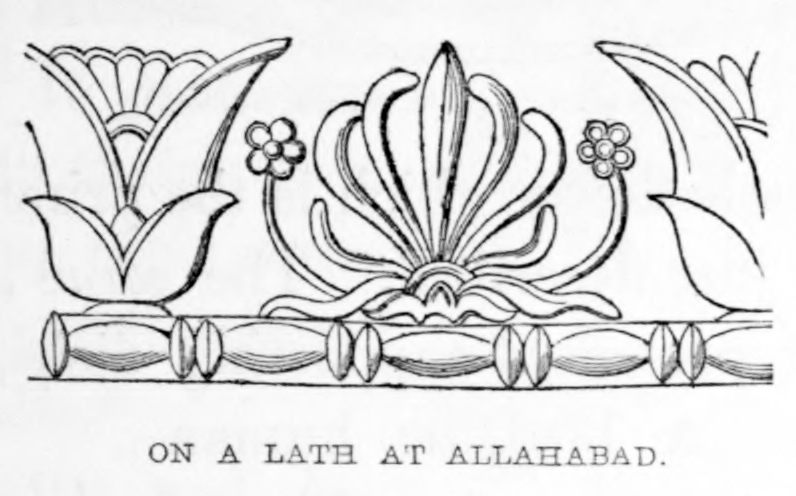
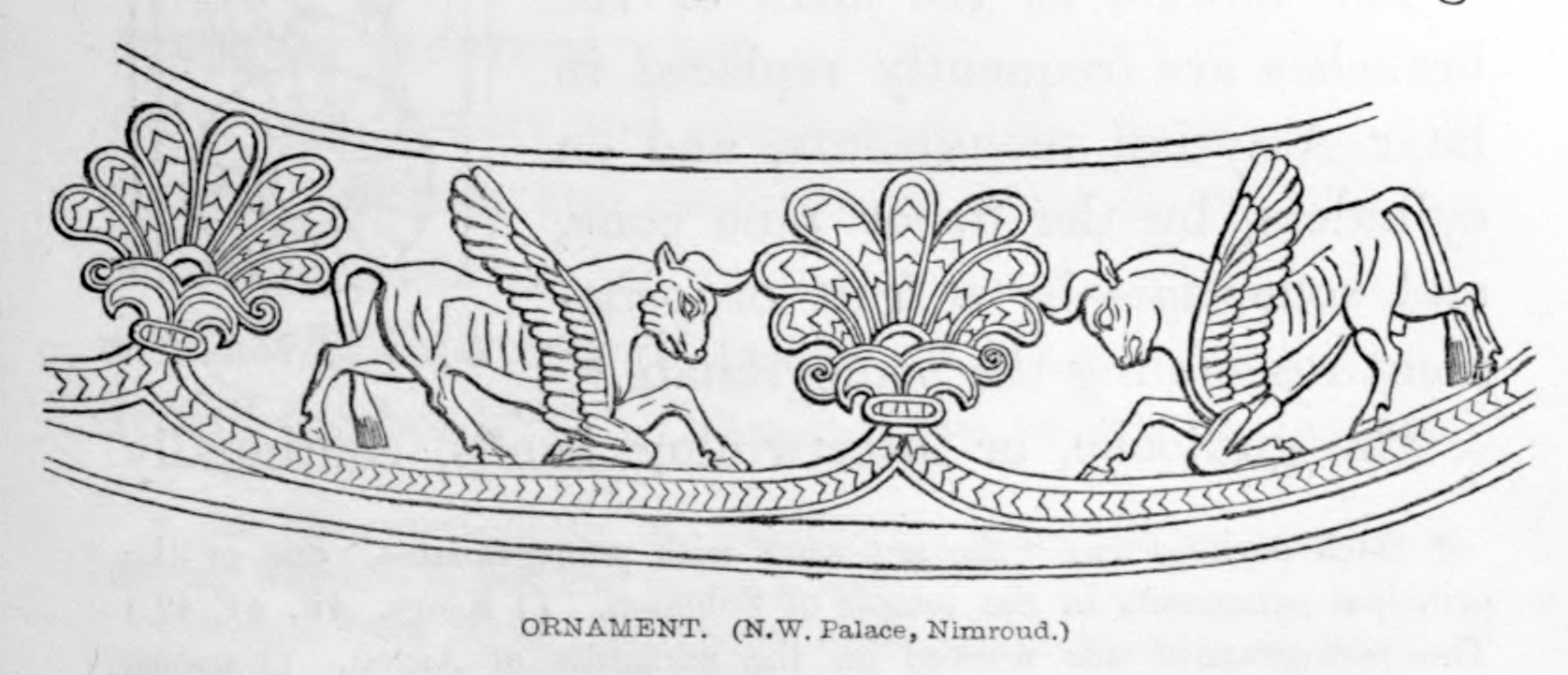
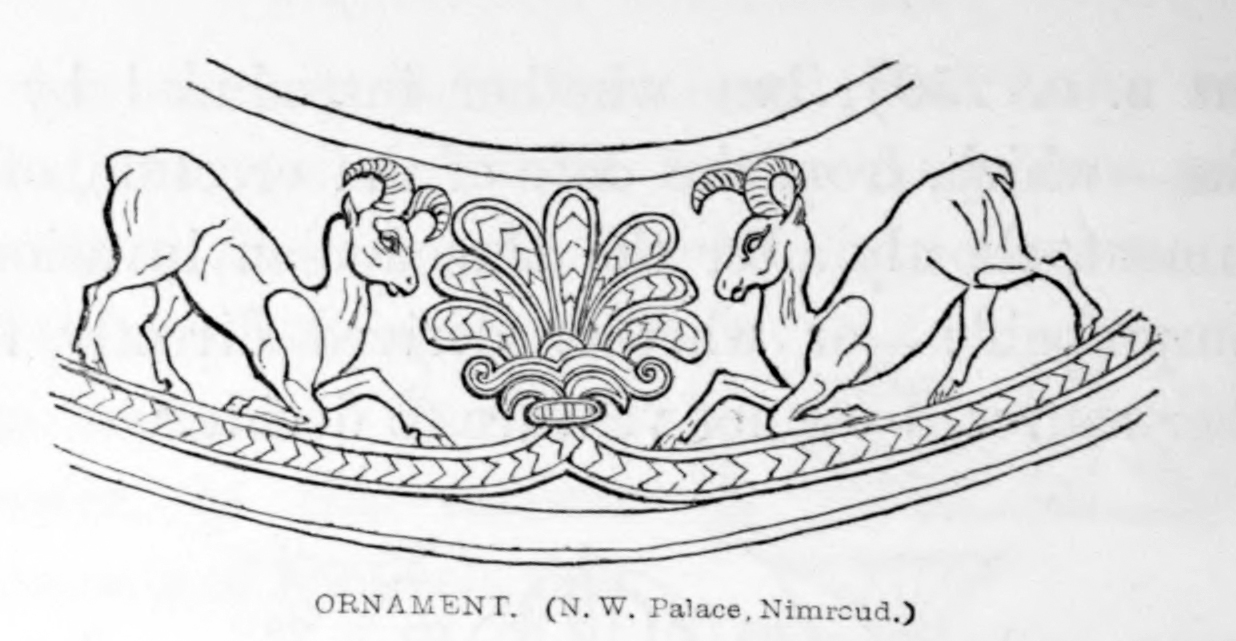

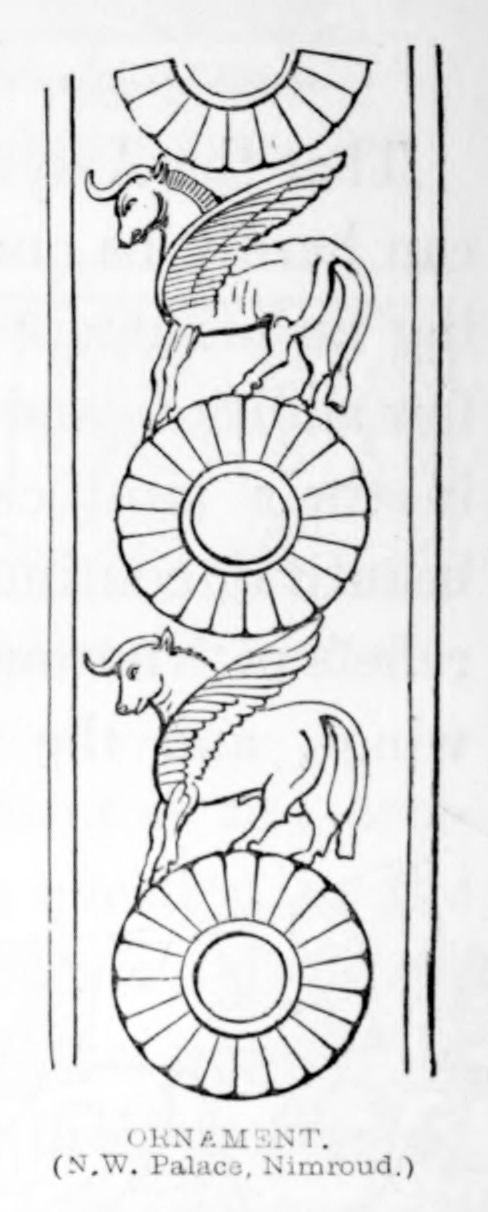 before the mystic flower which is the principal feature in the border just described. The same animals are occasionally represented supporting disks, or flowers and rosettes. A bird, or human figure, frequently takes the place of the bull and goat; and the simple flower becomes a tree, bearing many flowers of the same shape. This tree, evidently a sacred symbol, is elaborately and tastefully formed; and is one of the most conspicuous ornaments of Assyrian sculpture.
The flowers at the ends of the branches are frequently replaced in later
Assyrian monuments, and on cylinders, by the fir or pine cone, and sometimes by
a fruit or ornament resembling the pomegranate.
before the mystic flower which is the principal feature in the border just described. The same animals are occasionally represented supporting disks, or flowers and rosettes. A bird, or human figure, frequently takes the place of the bull and goat; and the simple flower becomes a tree, bearing many flowers of the same shape. This tree, evidently a sacred symbol, is elaborately and tastefully formed; and is one of the most conspicuous ornaments of Assyrian sculpture.
The flowers at the ends of the branches are frequently replaced in later
Assyrian monuments, and on cylinders, by the fir or pine cone, and sometimes by
a fruit or ornament resembling the pomegranate.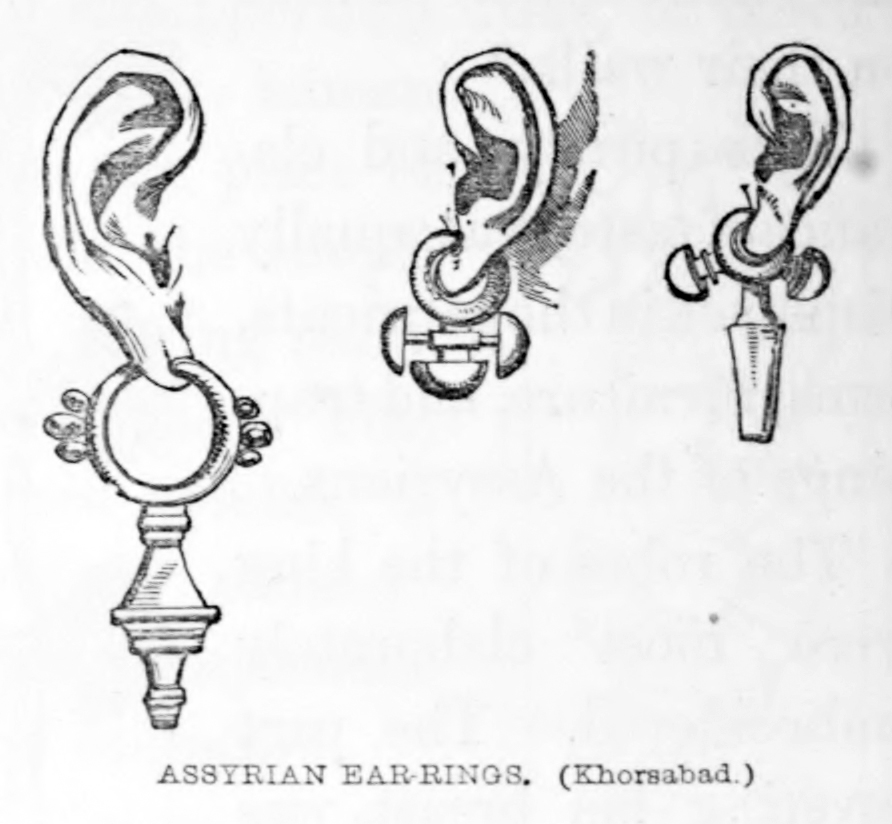
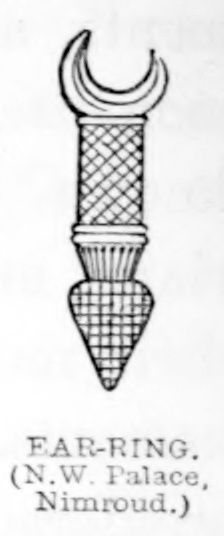 In their arms, the Assyrians rivalled even
the Greeks in elegance of design. The hilt
of the sword was frequently ornamented with four lions'
heads; two, with
part of the neck and
shoulders, made the
cross-bar or defence,
and two more with
extended jaws were
introduced into the
handle. The end of
the sheath was formed by two entire lions, clasped together, their heads turned outwards, and their
mouths open. Sometimes the whole of the sheath
was engraved, or embossed, with groups of human
figures, animals, and flowers.
In their arms, the Assyrians rivalled even
the Greeks in elegance of design. The hilt
of the sword was frequently ornamented with four lions'
heads; two, with
part of the neck and
shoulders, made the
cross-bar or defence,
and two more with
extended jaws were
introduced into the
handle. The end of
the sheath was formed by two entire lions, clasped together, their heads turned outwards, and their
mouths open. Sometimes the whole of the sheath
was engraved, or embossed, with groups of human
figures, animals, and flowers.
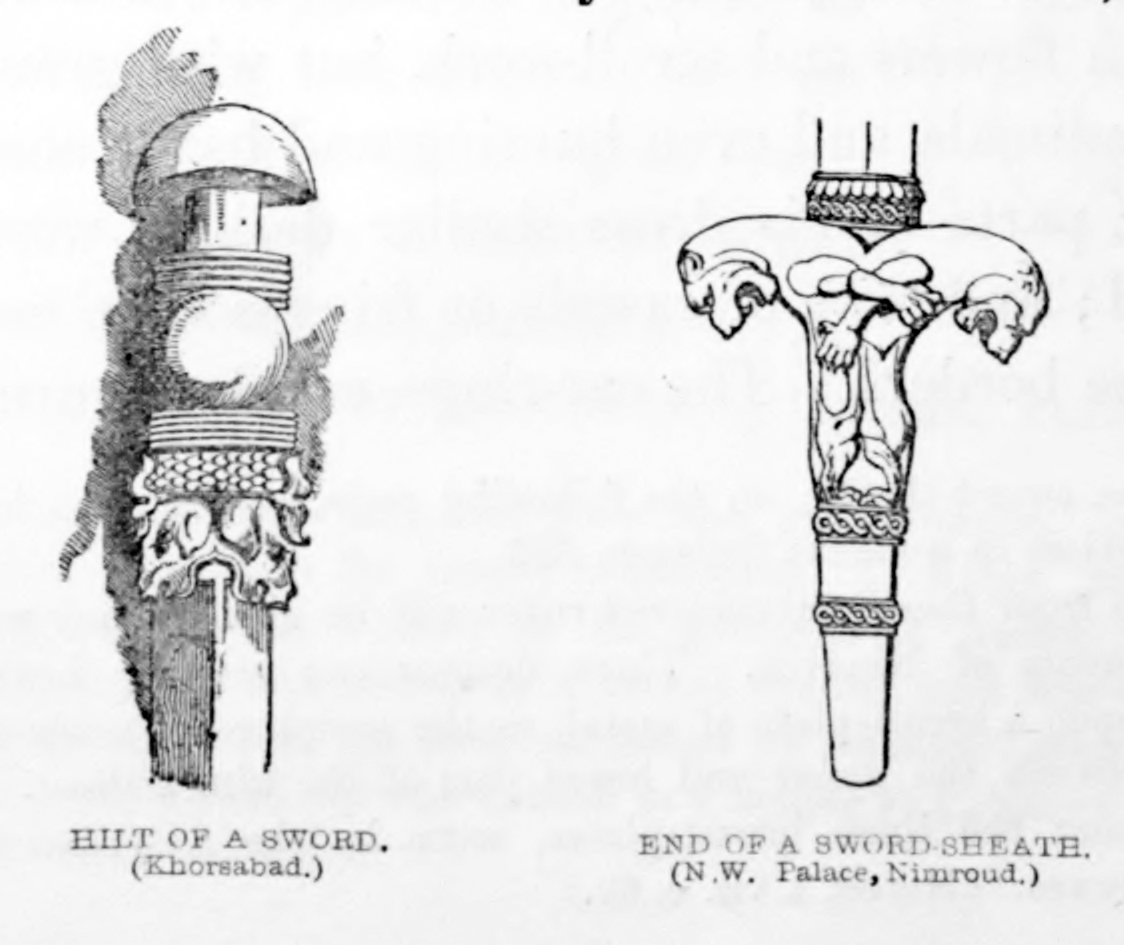
 The handles of the daggers
were no less highly ornamented, being sometimes in
the form of the head of a horse,
bull, or ram. The sheath frequently terminated in the head
of a bird, to which a tassel was
suspended. The part of the
bow to which the string was
attached, was in the shape of
an eagle's head. The quiver
was richly decorated with groups of figures, and fanciful designs.
The handles of the daggers
were no less highly ornamented, being sometimes in
the form of the head of a horse,
bull, or ram. The sheath frequently terminated in the head
of a bird, to which a tassel was
suspended. The part of the
bow to which the string was
attached, was in the shape of
an eagle's head. The quiver
was richly decorated with groups of figures, and fanciful designs.


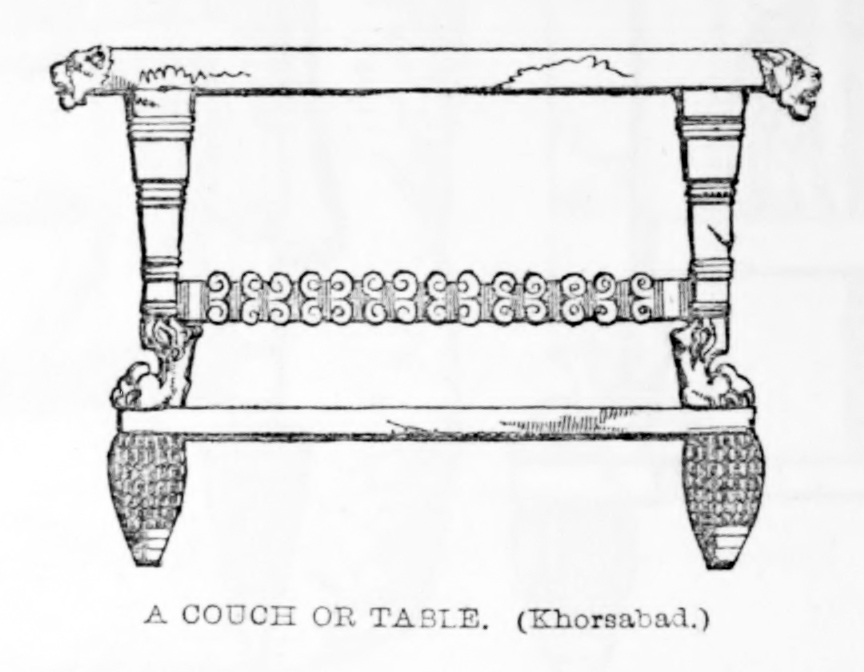
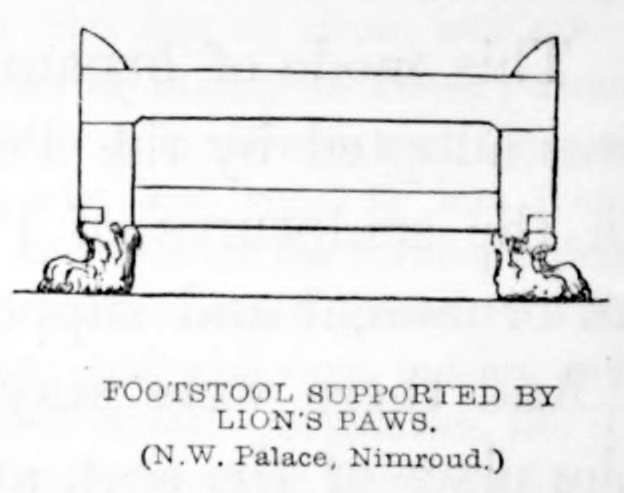 The forms of the furniture represented in the bas-reliefs of the later period, as at Khorsabad, display
less taste and elegance than those of the earlier
monuments. The chairs have generally more than
one cross-bar, and are somewhat heavy and ill-proportioned, the feet resting upon large inverted cones,
resembling pine-apples. The seats were high, the
feet of those who sat upon
them being raised considerably above the ground; a
footstool was consequently
necessary. On the earliest
Assyrian monuments the shape
of the footstool is very beautiful; like the chair, it
was ornamented with the paws of lions, or the hoofs
of bulls.
The forms of the furniture represented in the bas-reliefs of the later period, as at Khorsabad, display
less taste and elegance than those of the earlier
monuments. The chairs have generally more than
one cross-bar, and are somewhat heavy and ill-proportioned, the feet resting upon large inverted cones,
resembling pine-apples. The seats were high, the
feet of those who sat upon
them being raised considerably above the ground; a
footstool was consequently
necessary. On the earliest
Assyrian monuments the shape
of the footstool is very beautiful; like the chair, it
was ornamented with the paws of lions, or the hoofs
of bulls.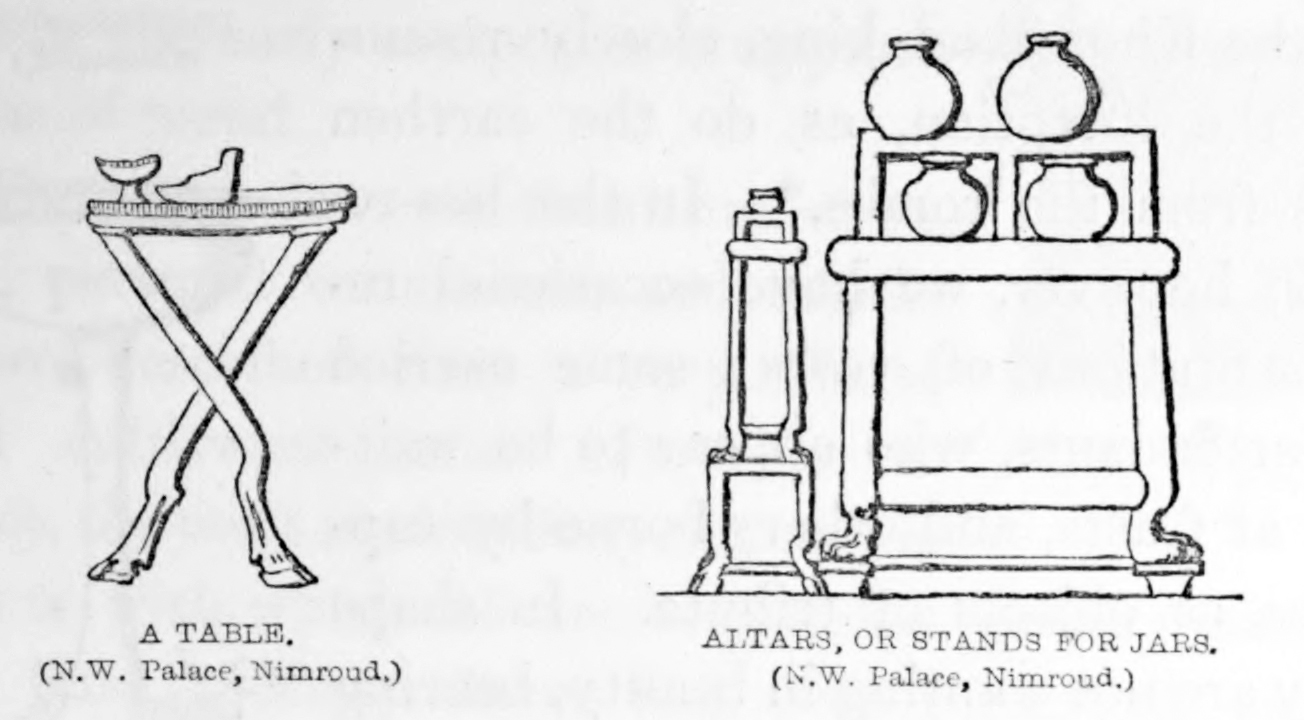
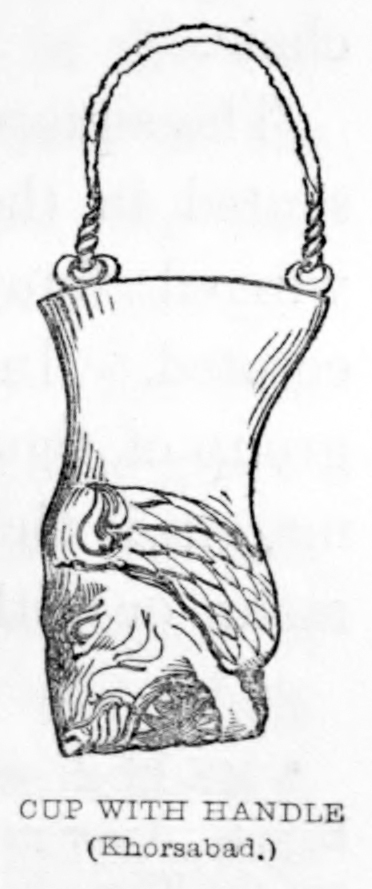 The drinking cups, and vessels, used on festive occasions were probably of gold, like those
of Solomon
The drinking cups, and vessels, used on festive occasions were probably of gold, like those
of Solomon †=
†= It is remarkable that the later Assyrians, whilst
retaining ancient forms in their arms, should have
discontinued their use in the embroideries of their robes; no longer introducing the groups of figures,
which previously formed so elegant and important
an ornament. This can scarcely be ascribed to a
mere modification of taste. As all these groups
have evident reference to myths, and sacred subjects, their omission appears to confirm the conjecture that an essential change had taken place in
the religious system, as well as in the manners, of
the Assyrians, between the construction of the earliest and latest monuments.
It is remarkable that the later Assyrians, whilst
retaining ancient forms in their arms, should have
discontinued their use in the embroideries of their robes; no longer introducing the groups of figures,
which previously formed so elegant and important
an ornament. This can scarcely be ascribed to a
mere modification of taste. As all these groups
have evident reference to myths, and sacred subjects, their omission appears to confirm the conjecture that an essential change had taken place in
the religious system, as well as in the manners, of
the Assyrians, between the construction of the earliest and latest monuments.